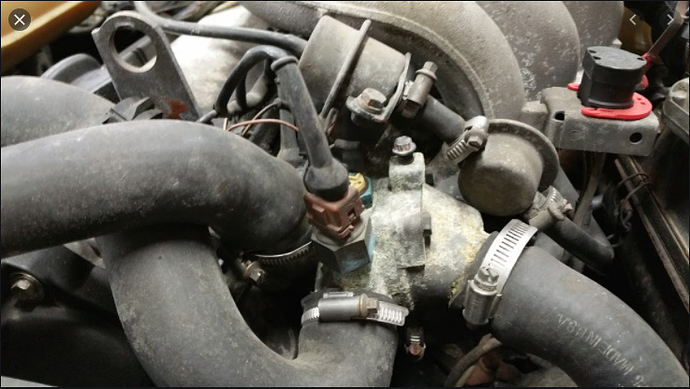Here’s an easier way to install a coolant pressure switch. Put it in the thermostat housing.
Thermostat housings, depending on their year, have 2 or 4x 14mm ports in them. In the pic below note the brown temp sensor–that goes to the cluster’s temp gauge.
Of those 2-4 ports, leave the one with the blue sensor alone. The others are fair game to dick with. If you have a 2 port thermostat housing, you can either drill out one of the missing ports, the flat round surface where it goes is easy to spot, or you can get a 4 port thermostat housing on ebay or R3VLimited’s facebook page.
If you don’t have a “decent” temp gauge and are therefore using the cluster’s temp gauge, leave the brown sensor alone and use one of the other ports for your temp switch. If it has an available port, get a 14mm to 1/8NPT adapter, because most pressure sensors are 1/8NPT.
My “Matthew Agurkis” car has a 4 port thermostat housing. This evening I removed the brown sensor, threaded in a 14mmx1/8NPT adapter and a 4psi sensor.
The brown sensor location is on the hot side of the thermostat. The other ports, not visible in the pic, are on the cold side of the thermostat. Remember that distinction if you put a temp sensor on the cold side.
If you have a 2 port thermostat housing and are therefore going to make a port for your pressure switch, drill a hole in the housing and tap it for 1/8NPT. Just be aware that NPT threads are not straight, they get bigger the farther you thread them in. So don’t run the tap too deep. The first time tap the treads in just a bit and check to see if your switch threads in ok. If the switch won’t thread in deeply enough, use your tap and run it down a little bit deeper. Just be sure you don’t run the tap in too deep or the switch will bottom out in your hole it won’t be tight. Then you’re screwed.
The best solution is to remote your pressure switch on a short length of hose. This is because most pressure switches are a bit too delicate for the heat and vibration of the engine. But if you get a good pressure switch, one the is designed to be fastened right to an engine–an oil pressure switch is a good example, it will probably survive being directly attached just fine.
For this location, I would use 2-4psi for your pressure switch. Up to 7psi might work. Expect your coolant pressure switch to stay illuminated until your engine gets hot. Your pump doesn’t pressurize the system much, it’s the micro-boiling in the block and head that make the system pressurized.
If you’re using the temp gauge on the cluster, go buy yourself a better one. It took me a long time to accept that cheap gauges suck. Me being a cheapskate, that kinda thing goes down hard. 52mm Auxiliary Gauges: Pro-Control



